Wavefront Guided Scleral Lens
Katy, Texas
Welcome to our comprehensive guide on wavefront guided scleral lenses, an innovative contact lens solution designed for patients with irregular corneas and higher order aberrations (HOAs).
This page aims to provide you with a detailed understanding of how these advanced lenses can significantly improve vision quality for those affected by conditions like keratoconus, corneal transplants, and post-refractive surgery complications. Whether you are seeking relief from the frustrating symptoms of HOAs or exploring cutting-edge vision correction options, our goal is to offer valuable insights and highlight the benefits of wavefront guided scleral lenses.
Understanding Higher Order Aberrations (HOAs)
Higher Order Aberrations (HOAs) are complex imperfections in the eye’s optical system that cannot be corrected by standard glasses or contact lenses. Unlike lower-order aberrations such as nearsightedness, farsightedness, and astigmatism, which can be easily addressed with conventional corrective lenses, HOAs affect the quality of vision in more subtle and intricate ways.
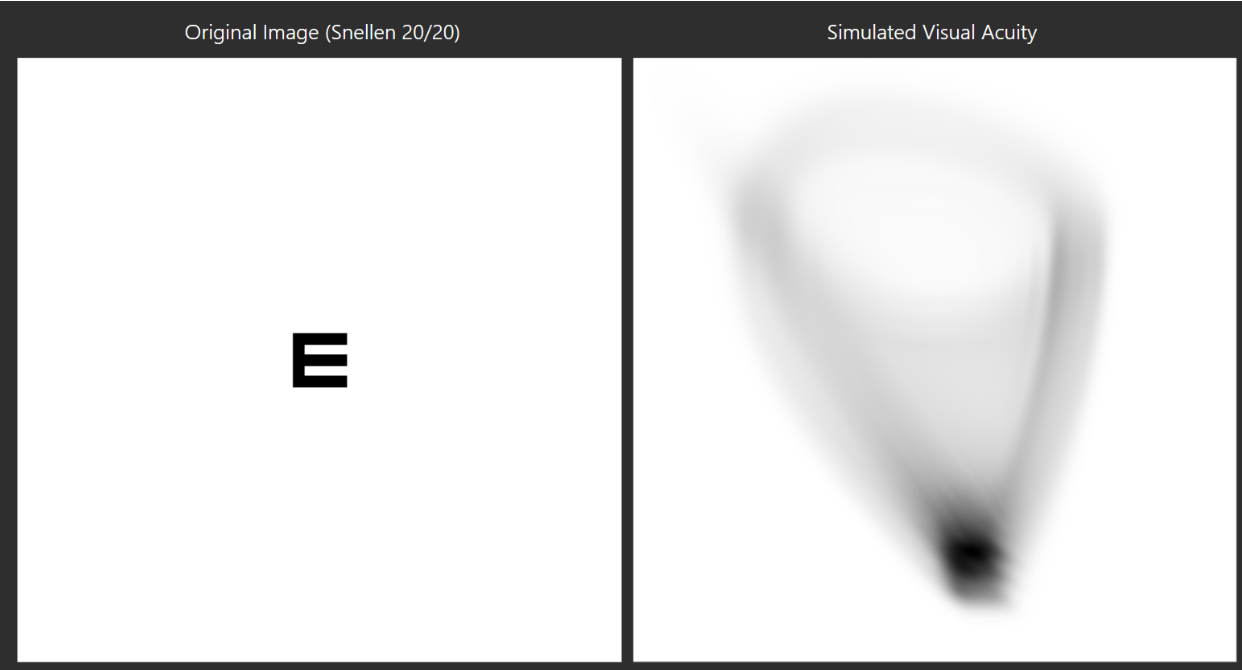
Simulated retinal image of how an individual with elevated levels of higher order aberrations (HOAs), specifically coma, may view the letter ‘E’.

This graphic is a Point Spread Function (PSF). A PSF represents how an individual views a single point of light, for example a star in the sky. (A) Representation of how an individual with normal HORMS would view a light. (B) Illustration of how an individual with elevated HORMS views a light. Notice the extreme distortions in this photo.
Common Causes of HOAs
HOAs often arise from irregularities in the cornea, the eye’s clear, dome-shaped front surface. Various conditions can cause these irregularities, leading to HOAs:
Keratoconus: A progressive eye disease where the cornea thins and bulges into a cone-like shape.
Corneal Transplants: Surgical procedures that replace a damaged cornea with a healthy one from a donor, which can sometimes lead to irregular healing.
Refractive Surgeries: Procedures like LASIK, RK (Radial Keratotomy), and PRK (Photorefractive Keratectomy) intended to correct vision but occasionally resulting in irregular corneal surfaces.
Symptoms of HOAs
Patients with HOAs often experience a variety of visual disturbances that significantly impact their quality of life. Common symptoms include:
Shadows: Ghost images that appear beside the primary image.
Glare: Unwanted light scattering that creates a hazy or starburst effect around lights.
Distortions: Warped or wavy vision, making straight lines appear bent.
Smudging: Blurred or smeared vision that makes it difficult to see fine details.
Multiple Images: Seeing double or multiple images of a single object, particularly in low-light conditions.
Understanding and diagnosing HOAs is crucial for finding the right treatment to improve vision clarity and overall quality of life.
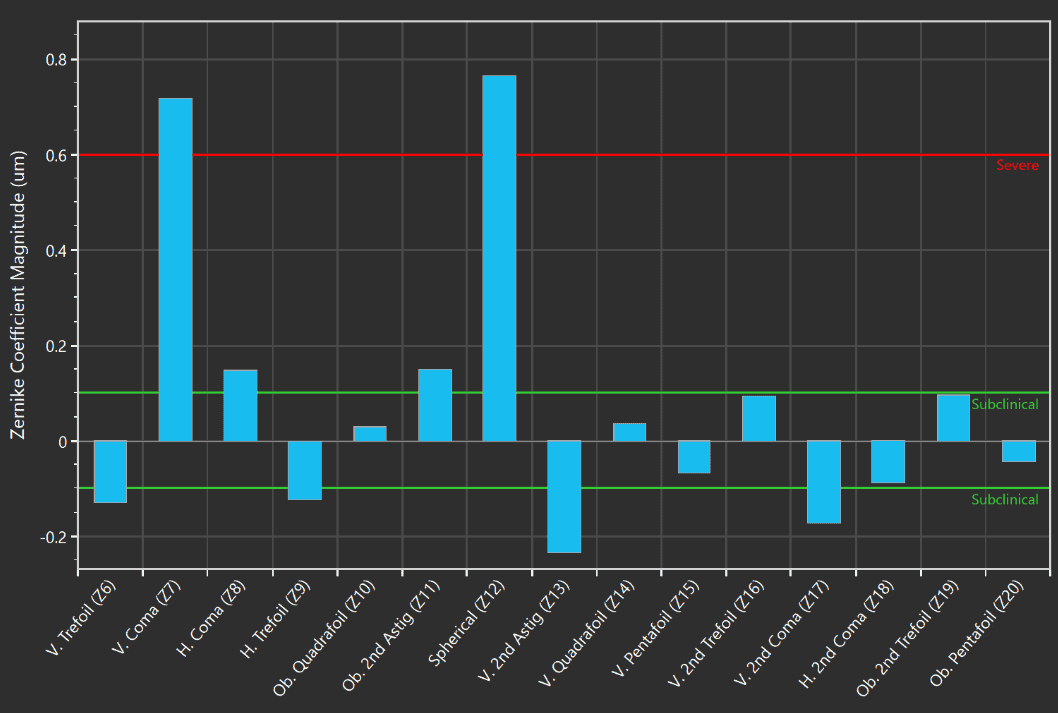
HORMS: 1.14 µm @ 6.0 mm pupil (normative HORMS: 0.37 µm)
This patient has elevated levels of trefoil, coma, secondary astigmatism, and spherical aberration, which resulted in significant distortions
Measurement of HOAs
Accurately measuring Higher Order Aberrations (HOAs) is a critical step in diagnosing and treating these complex vision issues. This is where aberrometers come into play. Aberrometers are advanced diagnostic instruments that precisely measure the way light is distorted as it passes through the eye’s optical system. By analyzing these distortions, Dr. Kauffman can identify specific HOAs and their impact on vision.
One notable example of such technology is the Ovitz xwave aberrometer. This state-of-the-art device provides detailed wavefront measurements, capturing high-resolution data on the eye’s aberrations. The Ovitz xwave aberrometer uses cutting-edge wavefront sensing technology to map the unique optical fingerprint of each patient’s eye. This information is crucial for designing customized wavefront guided scleral lenses that target and correct specific HOAs, offering patients a tailored solution for clearer vision.
By utilizing aberrometers like the Ovitz xwave, eye care professionals can offer a higher level of precision in diagnosing and treating HOAs, leading to more effective and personalized vision correction options.
Challenges with Traditional Correction Methods
Standard glasses and contact lenses are designed to correct common vision problems like nearsightedness, farsightedness, and astigmatism. However, these conventional correction methods fall short when it comes to addressing Higher Order Aberrations (HOAs).
HOAs are more complex and subtle distortions in the eye’s optical system that cannot be corrected by simply changing the lens’s curvature or prescription. These aberrations occur at multiple points in the eye’s visual pathway, leading to visual disturbances that standard lenses cannot adequately address. Traditional correction methods lack the precision required to target these intricate imperfections.
For patients with HOAs, standard glasses or contact lenses may fail to eliminate symptoms such as shadows, glare, distortions, smudging, and multiple images. Instead of providing clear and sharp vision, these traditional methods often leave patients struggling with residual visual disturbances, significantly impacting their quality of life.
The inadequacy of conventional correction methods in treating HOAs underscores the need for advanced solutions like wavefront guided scleral lenses, which are specifically designed to address these higher order imperfections and provide clearer, more precise vision.
Introduction to Wavefront Guided Scleral Lenses
Wavefront guided scleral lenses represent a groundbreaking solution for individuals suffering from Higher Order Aberrations (HOAs) and irregular corneas. These advanced lenses are meticulously designed to reduce or minimize the complex distortions that conventional lenses cannot address.
What Are Wavefront Guided Scleral Lenses?
Wavefront guided scleral lenses are custom-designed contact lenses that rest on the sclera, the white part of the eye, and vault over the cornea without touching it. This unique design not only provides stability and comfort but also creates a smooth optical surface, effectively correcting the irregularities in the cornea. By using detailed wavefront measurements obtained from aberrometers, these lenses are precisely tailored to each patient’s specific optical imperfections.
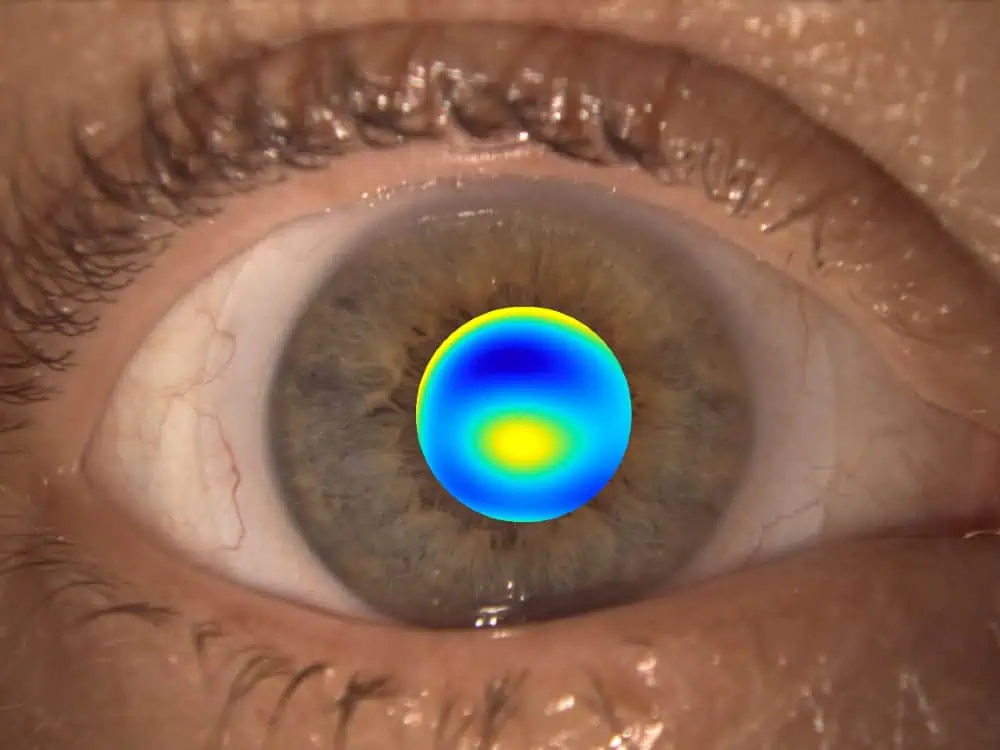
Corneal topography and wavefront maps look very similar, but a wavefront map (shown here) is measured across the pupil (avg: 4-6 mm in diameter) and a corneal topography is captured across the entire cornea (avg: 10-11 mm in diameter).
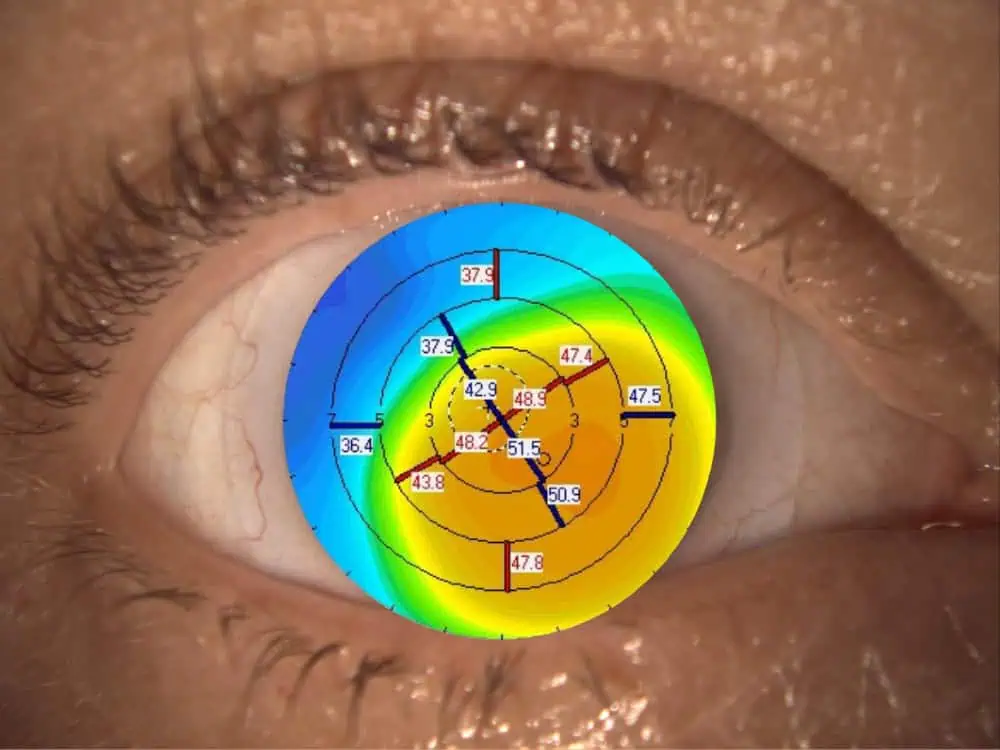
Corneal topography and wavefront maps look very similar, but a corneal topography (shown here) is captured across the entire cornea (avg: 10-11 mm in diameter) and a wavefront map is measured across the pupil (avg: 4-6 mm in diameter).
How Do They Work?
The wavefront technology involved in these lenses maps out the unique optical aberrations in the eye. This data is then used to create a lens that reduces or minimizes these distortions, providing a highly personalized vision correction solution. The result is a significant reduction in visual disturbances such as glare, halos, and multiple images, leading to clearer and sharper vision.
Benefits for Patients with Irregular Corneas
Patients with conditions like keratoconus, corneal transplants, and post-refractive surgery complications often experience irregular corneal surfaces that standard lenses cannot adequately address. Wavefront guided scleral lenses offer an effective alternative, providing enhanced vision clarity and improved quality of life for those affected by HOAs. These lenses not only correct the irregularities but also provide a comfortable and secure fit, making them ideal for daily wear.
Wavefront guided scleral lenses are a revolutionary advancement in eye care, offering a tailored and effective solution for patients struggling with complex visual aberrations. By embracing this cutting-edge technology, individuals with irregular corneas can experience a remarkable improvement in their vision.
Our Exclusive Offering: Ovitz Designed Wavefront Guided Scleral Lenses
We are proud to announce that our office is the first and only in the Houston area to offer Ovitz designed wavefront guided scleral lenses. This exclusive offering provides our patients with access to the latest in vision correction technology, ensuring the best possible outcomes for those struggling with Higher Order Aberrations (HOAs) and irregular corneas.
Benefits of Ovitz Designed Wavefront Guided Scleral Lenses
Ovitz designed wavefront guided scleral lenses stand out from other options due to their advanced customization and precision. Here are some of the key benefits:
Tailored Vision Correction: Using detailed wavefront measurements, these lenses are custom-designed to address each patient’s unique optical imperfections, providing superior clarity and sharpness.
Enhanced Comfort: The scleral design ensures that the lenses rest on the white part of the eye, avoiding direct contact with the sensitive cornea. This results in a more comfortable and stable fit, even for those with highly irregular corneas.
Reduced Visual Disturbances: By specifically targeting HOAs, Ovitz designed lenses significantly reduce symptoms such as glare, halos, shadows, and multiple images, leading to a clearer and more comfortable visual experience.
Improved Quality of Life: Patients who switch to wavefront guided scleral lenses often report a marked improvement in their daily activities, thanks to the enhanced vision and comfort these lenses provide.
Why Choose Ovitz Designed Lenses?
Ovitz designed wavefront guided scleral lenses incorporate cutting-edge technology and meticulous design, setting them apart from traditional contact lenses and other scleral lens options. By choosing our exclusive offering, patients can benefit from:
- Access to the Latest Technology: As the only provider in Houston offering Ovitz designed lenses, we bring the most advanced vision correction solutions to our community.
- Expert Care and Customization: Our team is highly trained in fitting and managing these specialized lenses, ensuring that each patient receives personalized care and the best possible outcome.
Experience the difference with Ovitz designed wavefront guided scleral lenses and take the first step towards clearer, more comfortable vision today.
Next Steps
If you are experiencing vision issues related to Higher Order Aberrations (HOAs) or irregular corneas, we encourage you to schedule a consultation with our Dr. Kauffman. He will assess your unique visual needs and determine if wavefront guided scleral lenses are the right solution for you. During your consultation, we will:
- Perform a comprehensive eye examination.
- Measure your HOAs using advanced aberrometry technology.
- Discuss your vision concerns and goals.
- Provide detailed information about wavefront guided scleral lenses.
- Answer any questions you may have.
Take the first step towards clearer, more comfortable vision by contacting us today to schedule your consultation.
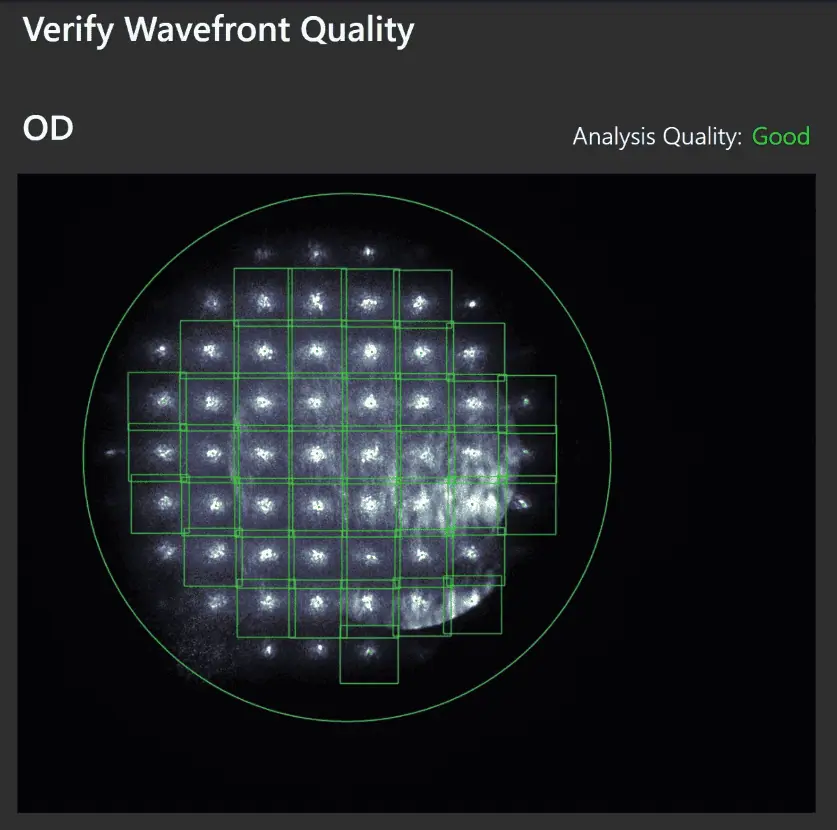
A good quality scan is required for the most accurate wavefront HORMS analysis. The green circle depicts the pupil size, and every box with a dot inside indicated a point of measurement across the pupil. Green boxes indicate an good quality data point.
Case Report
- 33 y/o male diagnosed with keratoconus
- Left eye more severe than right eye
Current scleral lens (OS)
- VA: 20/40-2
- HORMS: 1.17 µm (age-matched normal = 0.17 ± 0.06 µm)
- Significant visual distortions—contemplating corneal transplant for vision improvement
- Note the poor quality of vision on the letter chart on the right-hand side
Schedule an Appointment
Are you ready to schedule your next appointment? Just click the link below and fill out the necessary information. We’ll follow up with an appointment confirmation. Need to modify your upcoming appointment time? Contact us directly and we’ll work with you to come up with a new time that works best for your schedule.


